



















|
 |
|
 |

The Getai can command a variety of local units in almost any battlefield role and often of good quality. Skirmishers, line infantry, horse archers, medium cavalry & shock troops are available from their homelands and their Thrakian neighbours to the south.
Should Getia's borders expand other troop types can be raised for the Getic armies.
Komatai (Dacian Skirmishers)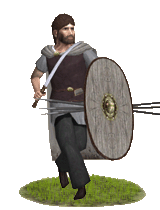 The Komatai, also called 'daoi' or 'wolves,' make up the bulk of the tribal forces of the Getai. Untamed warriors, they are still capable of versatile maneuvers on the battlefield. They fight bare-headed to assure the gods of their fervor and willingness to arrive at their side. The Komatai go to battle wearing studded leather armor, baggy trousers and a large oval shield. They also carry with them javelins and a sica. They are best used as skirmishers for hit-and-run tactics and can be deadly in forests. If forced into melee they can hold their own against other light and even some medium infantry. The Komatai, also called 'daoi' or 'wolves,' make up the bulk of the tribal forces of the Getai. Untamed warriors, they are still capable of versatile maneuvers on the battlefield. They fight bare-headed to assure the gods of their fervor and willingness to arrive at their side. The Komatai go to battle wearing studded leather armor, baggy trousers and a large oval shield. They also carry with them javelins and a sica. They are best used as skirmishers for hit-and-run tactics and can be deadly in forests. If forced into melee they can hold their own against other light and even some medium infantry.
Historically, the Komatai were the perfect example of the transitional process of the tribal communities to a stately structure. They were free men, still gathering at the tribe's calling, but the tribe's calling was increasingly a response to a call from a tribal union or from the Basileus himself. By the middle of the third century BC large unions of tribes had begun to fight for the hegemony in the area from the Karpathes to the Istros. The Komatai made up the vast majority of warriors, while the disparities between the komatai and the noble tarabostes grew to an even greater extent. The Getic warriors were renowned for their zeal in battle-it was rumored that they did not fear death because of their belief in the immortality of their souls.
Komatai Sphendonetai (Dacian Slingers)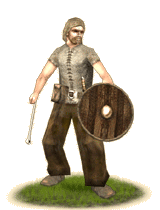 These skirmishers are a valuable addition to any Getic army and can perform superbly in rough terrain. They carry no armor to speak of, except small round shields, and are armed with slings and an akinakes dagger. They are usually very young men and their role is merely to try and force the enemy into acting rashly, even though unarmored troops could pay much more dearly if facing them. Any wise leader should try to keep them away from prolonged melees, even though they will fight back with more vigor than troops of this type are expected. These skirmishers are a valuable addition to any Getic army and can perform superbly in rough terrain. They carry no armor to speak of, except small round shields, and are armed with slings and an akinakes dagger. They are usually very young men and their role is merely to try and force the enemy into acting rashly, even though unarmored troops could pay much more dearly if facing them. Any wise leader should try to keep them away from prolonged melees, even though they will fight back with more vigor than troops of this type are expected.
Historically, these slingers had no distinct ability from their counterparts, though they acted more independently on the battlefield and were probably more accustomed to flank attacks than form a loose fore-front as the Greek psiloi. Their numbers were never great, thanks to the popularity of the bow among the Getai. Their akinakes and small shields offered them enough protection not to fear acting as support troops.
Mezenai (Dacian Light Cavalry)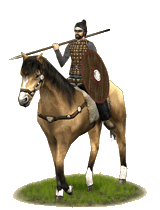 These horsemen form the mounted counterparts of the Komatai war bands. They ride into battle armored with studded leather armor and trousers, while carrying javelins, spears and short swords. Their nimble horses allow for very good performance in any type of terrain, being often used to screen flanks, charge home and for pursuit once an enemy is broken. They are also expert scouts and perfectly suited for the scorched-earth raiding tactics commonly used by the Getai. While they can pose problems to heavy cavalry when using javelins, they’ll also carve a bloody path through most medium cavalry with their daggers. These horsemen form the mounted counterparts of the Komatai war bands. They ride into battle armored with studded leather armor and trousers, while carrying javelins, spears and short swords. Their nimble horses allow for very good performance in any type of terrain, being often used to screen flanks, charge home and for pursuit once an enemy is broken. They are also expert scouts and perfectly suited for the scorched-earth raiding tactics commonly used by the Getai. While they can pose problems to heavy cavalry when using javelins, they’ll also carve a bloody path through most medium cavalry with their daggers.
Historically, the word mezena is a purely thracian one meaning rider or horseman as a tomb inscription reveals. These riders were nothing more than komatai who could afford losing their horse on the battlefield. They preferred the short sword to the common sica due to their stabbing effectivness and in pursuit. Their numbers fluctuated, and could at times be considerable. When Alexandros pushed up to the Danube, many thousands from the mezenai confronted him there.
Komatai Toxotai (Dacian Archers)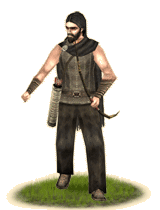 The bow had an important role in Getic rituals and thus experienced archers would always be appreciated within their community. Also, hunting was a primary occupation, and their widely forested lands provided them with all the game they needed. In times of war, hunters and skilled archers thus formed into war bands. Apart from the bow they only have a short spear and wear leather armor, armguards and baggy trousers for protection. The Getai preferred harassment tactics over pitched battle in many cases, and thus the bow is looked upon highly by the tribal warriors. Thus, these archers should be used for harassing the enemy formations, breaking them up before a strong infantry charge is mounted, preferably by the Drapanai for best effect. In forested areas the Komatai Toxotai can be lethal as their background makes them expert at using the forest to their advantage. While more than excellent archers, they should not be expected to perform equally well in close-combat, as their short spears impede closing in safely on the enemy in the absence of a shield. The bow had an important role in Getic rituals and thus experienced archers would always be appreciated within their community. Also, hunting was a primary occupation, and their widely forested lands provided them with all the game they needed. In times of war, hunters and skilled archers thus formed into war bands. Apart from the bow they only have a short spear and wear leather armor, armguards and baggy trousers for protection. The Getai preferred harassment tactics over pitched battle in many cases, and thus the bow is looked upon highly by the tribal warriors. Thus, these archers should be used for harassing the enemy formations, breaking them up before a strong infantry charge is mounted, preferably by the Drapanai for best effect. In forested areas the Komatai Toxotai can be lethal as their background makes them expert at using the forest to their advantage. While more than excellent archers, they should not be expected to perform equally well in close-combat, as their short spears impede closing in safely on the enemy in the absence of a shield.
Historically, Getic archers were a valorous force, superior in skill to all their neighbors, save perhaps the Skythians. Archery reached its pinnacle probably around the first century AD, by which time the composite bow had been adopted on a nearly universal scale.
Drapanai (Dacian Shock Infantry)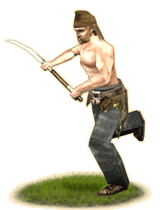 The Drapanai contingents are made up of resolute warriors, well aware of their role on the battlefield as shock troops. While the average Getic soldier tells himself he is immortal, the Drapanai, more than any others, join battle without fear of death. They fight bare-chested and with only baggy trousers, not for protection but to keep some warmth. Their trademark though is the falx, a vicious blade capable of severing limbs and causing horrible wounds with a single, crushing blow. These warriors are best used as shock troops against enemy infantry. If used properly, they can cut their way through and open a gap in the enemy battle line, allowing other Getic warriors to exploit the opening. Their lack of armor might be a drawback against concentrated enemy missile fire and they should thus not be exposed to enemy ranged infantry needlessly. The Drapanai contingents are made up of resolute warriors, well aware of their role on the battlefield as shock troops. While the average Getic soldier tells himself he is immortal, the Drapanai, more than any others, join battle without fear of death. They fight bare-chested and with only baggy trousers, not for protection but to keep some warmth. Their trademark though is the falx, a vicious blade capable of severing limbs and causing horrible wounds with a single, crushing blow. These warriors are best used as shock troops against enemy infantry. If used properly, they can cut their way through and open a gap in the enemy battle line, allowing other Getic warriors to exploit the opening. Their lack of armor might be a drawback against concentrated enemy missile fire and they should thus not be exposed to enemy ranged infantry needlessly.
Historically, a Drapanai soldier is the archetype of the Getic warrior, bare-chested and armed with the falx. The falx weapon was developed from the Thracian rhomphaia and it became a traditional weapon among the Getai. The ones wielding it and who often made up the Drapanai were young vigorous warriors, striving to achieve recognition among their kin and fellow men. The religious aspects should not be overlooked either, as these men formed the frontline and served as shock troops which meant they were more exposed to the enemy, where the Getic religious zeal was of immense importance as these warriors did not fear death, because death was the gateway to their prophet-god Zalmoxis. Their valor is best shown during the Second Dacian War, when the Roman soldiers were issued new types of armor, greaves, modified helmets and especially stronger armguards to protect themselves against the falx, and Roman troops stationed in Dacia, as the Romans called Getia, in the later first century AD were still issued these armguards and armor pieces so not to lose their limbs!
Komatai Agrianai (Dacian Elite Archers)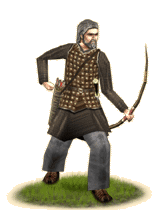 Recruited from the Getic mountain tribes, these men are superb archers, well able to use every piece of terrain in order to pepper the enemy with arrow fire. Not to be confused with the Agrian tribe of the Southern Rhodope, "Agrianai" was also used to denote mountain men. These men are wealthy komatai drawn from the Getic tribes dwelling along the Karpathes. They are armored with studded leather armor, woolen trousers and armed with the bow. They developed their taste for the bow from their contact with Skythians, especially the Agathyrsoi, who once ruled the Getai as overlords, and have since become, through time, intermarriage, and a little war, a Getic tribe themselves. Their incessant fighting in more recent years against migrating Celtic tribes led many of them to adopt the Celtic-style longsword, which made them deadly when closing in for the kill. These archers should be employed as most archers, from a safe distance from the enemy and used to pepper the enemy's vulnerable positions. Unlike most other archers though, these men can perform well in close combat, although they are most effective against weakened, exposed, or tired foes. Recruited from the Getic mountain tribes, these men are superb archers, well able to use every piece of terrain in order to pepper the enemy with arrow fire. Not to be confused with the Agrian tribe of the Southern Rhodope, "Agrianai" was also used to denote mountain men. These men are wealthy komatai drawn from the Getic tribes dwelling along the Karpathes. They are armored with studded leather armor, woolen trousers and armed with the bow. They developed their taste for the bow from their contact with Skythians, especially the Agathyrsoi, who once ruled the Getai as overlords, and have since become, through time, intermarriage, and a little war, a Getic tribe themselves. Their incessant fighting in more recent years against migrating Celtic tribes led many of them to adopt the Celtic-style longsword, which made them deadly when closing in for the kill. These archers should be employed as most archers, from a safe distance from the enemy and used to pepper the enemy's vulnerable positions. Unlike most other archers though, these men can perform well in close combat, although they are most effective against weakened, exposed, or tired foes.
Historically, these highlanders were a strange synthesis between the old and the new. While they were quickly to learn the methods of Celtic metallurgy, they held ferociously to their traditions, and probably impressed the Celts through their beliefs, as many of these Celts in southeastern Europe seem to start adopting Getic incineration rituals by the third century BC.
Komatai Epilektoi (Dacian Elite Skirmishers)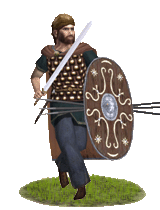 The Komatai Epilektoi are, literally, a unit of soldiers selected from among the Komatai. The basic komatai, equipped as fast-moving, hard-hitting skirmishers, made up a large percentage of most tribal armies, along with a number of archers and a mix of cavalry. Selected for their better equipment and superior physical abilities, the Komatai Epilektoi are a step beyond the standard Komatai. Equipped with the same studded leather armor worn over baggy trousers and woolen shirts, most of these men also wear greaves under their trousers and a simple iron helmet. They also can afford higher quality shields and better weapons: two heavier, well-made iron throwing spears and a Celtic long-sword are fairly standard. With their better equipment, they can stand in the battle line. Really, they are best used as ambushers and flankers, or for quick assaults against formations against which the other komatai would falter. Like many other Getai units, they are vulnerable to ranged fire, especially from the flanks or rear. so be sure to screen them when conducting hit-and-run attacks. The Komatai Epilektoi are, literally, a unit of soldiers selected from among the Komatai. The basic komatai, equipped as fast-moving, hard-hitting skirmishers, made up a large percentage of most tribal armies, along with a number of archers and a mix of cavalry. Selected for their better equipment and superior physical abilities, the Komatai Epilektoi are a step beyond the standard Komatai. Equipped with the same studded leather armor worn over baggy trousers and woolen shirts, most of these men also wear greaves under their trousers and a simple iron helmet. They also can afford higher quality shields and better weapons: two heavier, well-made iron throwing spears and a Celtic long-sword are fairly standard. With their better equipment, they can stand in the battle line. Really, they are best used as ambushers and flankers, or for quick assaults against formations against which the other komatai would falter. Like many other Getai units, they are vulnerable to ranged fire, especially from the flanks or rear. so be sure to screen them when conducting hit-and-run attacks.
Historically, light line infantry were common in Getic armies. Archaeologically, while higher quality weapons become much more common in Getic areas, increased armor does not, or at least not to so great an extent. This seems to reflect a Getic preference for mobility over protection, which fits well with what we know of Getic religiousity and their penchant for hit-and-run tactics.
Getikoi Hippotoxotai (Dacian Horse Archers)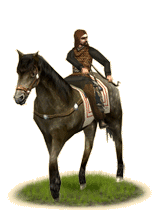 The Getai horse archers have a long and proud tradition, having developed superb skills in confrontations with the Skythai and Sauromatai. These Getai "who believe they are immortals" were the only tribes of the Thraikians whose horsemen confronted Dareios in his expedition against the Skythai in 514 BC, and for their "recklessness they were immediately subdued and forced to follow the huge Persai army, even though they are the bravest and most righteous of all Thraikes", as Herodotos notes. Their task is to kill, wound, disrupt, or simply reduce the morale of enemy infantry with endless showers of arrows, but they have problems like all horse archers in wet or damp weather. Their Skythian akinakes, a type of straight sword commonly used south of the Istros, and their fast horses enable them to make swift thrusts into the enemy flanks. However, one should never engage them in prolonged close quarters battle. The Getai horse archers have a long and proud tradition, having developed superb skills in confrontations with the Skythai and Sauromatai. These Getai "who believe they are immortals" were the only tribes of the Thraikians whose horsemen confronted Dareios in his expedition against the Skythai in 514 BC, and for their "recklessness they were immediately subdued and forced to follow the huge Persai army, even though they are the bravest and most righteous of all Thraikes", as Herodotos notes. Their task is to kill, wound, disrupt, or simply reduce the morale of enemy infantry with endless showers of arrows, but they have problems like all horse archers in wet or damp weather. Their Skythian akinakes, a type of straight sword commonly used south of the Istros, and their fast horses enable them to make swift thrusts into the enemy flanks. However, one should never engage them in prolonged close quarters battle.
Historically, the Getic horsemen won the admiration of the Hellenes when they decided to engage Dareios in Mikra Skythia; and they must have won the admiration of Dareios, as after their eventual defeat, they were pressed into service within the Persian army. Their numbers were large; Thoukydides notes, referring to the great army of supposedly 150,000 men, a third of it cavalry, recruited by the Odrysian king Sitalkes: "the largest part of the cavalry was provided by the Getai." Regarding their weapons, the composite bow transformed them into efficient killers while their horses kept them out of harm's way.
These Getai warriors are not drawn from every Getic tribe, but from the tribes living in the Danube-delta area or from the Agathyrsoi living inside the arch of the Karpathes. The Hellenes called all men living in modern-day Romania & northern Bulgaria for Getai after this tribe, while the Romans called them Dacians, which is the norm today. In earlier Greek history texts, Getai was used to describe just the one tribe, not the other tribes as well, which the term encompassed later on, when the tribes in the Carpatho-Danubian area became more organized and united.
Komatai Pelekuphoroi (Costobocii Axemen )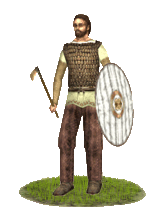 Combat traditions vary across the Getic tribes, and those on the northern and eastern sides of the Karpathoi are an excellent example. The two most powerful tribes of this region, the Karp and the Kostobok, are also among the most powerful of all the Getai. But aside from occasional wars among themselves or against their more settled neighbors to the south, these tribes are hardened by frequent war with both the nomadic Skythians, and the newly arrived Bastarnai, a migrating people ferocious in hand-to-hand combat. The battle-line warriors of the Karp and Kostobok tribes, aside from their large contingents of Drapanai, are the Pelekuphoroi, wielders of bronze axes and sturdy round shields. Even after the arrival of the iron age among their people, their warriors continued to show a preference for bronze axeheads, which, while having neither the weight nor reach of a falx, could still be devastating against armored opponents, and was more readily available among the komatai class. Their scale leather is meant at least as much to protect against Skythian arrows as against Bastarnai spears, and will do little stop a heavy, curved falx blade. These fast, hardy troops are best used in ambushes, hit-and-run attacks, or flanking maneuvers against heavier warriors, but are fierce enough to stand in the battle line if the situation demands it. Combat traditions vary across the Getic tribes, and those on the northern and eastern sides of the Karpathoi are an excellent example. The two most powerful tribes of this region, the Karp and the Kostobok, are also among the most powerful of all the Getai. But aside from occasional wars among themselves or against their more settled neighbors to the south, these tribes are hardened by frequent war with both the nomadic Skythians, and the newly arrived Bastarnai, a migrating people ferocious in hand-to-hand combat. The battle-line warriors of the Karp and Kostobok tribes, aside from their large contingents of Drapanai, are the Pelekuphoroi, wielders of bronze axes and sturdy round shields. Even after the arrival of the iron age among their people, their warriors continued to show a preference for bronze axeheads, which, while having neither the weight nor reach of a falx, could still be devastating against armored opponents, and was more readily available among the komatai class. Their scale leather is meant at least as much to protect against Skythian arrows as against Bastarnai spears, and will do little stop a heavy, curved falx blade. These fast, hardy troops are best used in ambushes, hit-and-run attacks, or flanking maneuvers against heavier warriors, but are fierce enough to stand in the battle line if the situation demands it.
Ischyroi Orditon (Elite Dacian Infantry)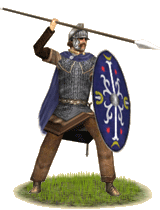 The Ischyroi Orditon, or "Mighty men of the Ordes," are the elite guard among the Getai. They trace their lineage back to the old capital at Helis, are the pinnacle of the Getic noble infantry. As the nobility of the tribe of the Ordes, they are equipped and supported by the Basileus, and unlike the tarabostes lords in their far-removed hillforts, the warrior lords of the Ordes are loyal retainers--and frequently family members--of the Getic kings. Armed with a long thrusting spear and either a sica or Keltic sword, they can be very effective in close combat with infantry and even cavalry. Protected by an iron Thraikian helm with a large iron crest, imported from Hellas, a large oval shield with a strong iron boss, a coat of mail, and occasionally greaves, they are one of the most heavily armored units in any Getic army. They are an expensive unit to train and maintain, but they are a valuable force on the battlefield, capitalizing on Getic fierceness and borrowed Hellenic and Keltic techniques to stand toe-to-toe with enemy heavy infantry.
The Ischyroi Orditon, or "Mighty men of the Ordes," are the elite guard among the Getai. They trace their lineage back to the old capital at Helis, are the pinnacle of the Getic noble infantry. As the nobility of the tribe of the Ordes, they are equipped and supported by the Basileus, and unlike the tarabostes lords in their far-removed hillforts, the warrior lords of the Ordes are loyal retainers--and frequently family members--of the Getic kings. Armed with a long thrusting spear and either a sica or Keltic sword, they can be very effective in close combat with infantry and even cavalry. Protected by an iron Thraikian helm with a large iron crest, imported from Hellas, a large oval shield with a strong iron boss, a coat of mail, and occasionally greaves, they are one of the most heavily armored units in any Getic army. They are an expensive unit to train and maintain, but they are a valuable force on the battlefield, capitalizing on Getic fierceness and borrowed Hellenic and Keltic techniques to stand toe-to-toe with enemy heavy infantry.
Historically, after the Galatai destroyed Helis, the surviving population moved north of the Istros and rebuilt their capital at Argedava, now known as Popesti. What had been an insignificant fishing and agricultural settlement quickly became one of the largest in all of the Getic lands. The population at Helis had already been well-acquainted with advanced metallurgy, and traded extensively with Skythians, Kelts, and especially Hellenes. This did not change at Argedava, which--judging from archaeological remains--became the source for the best-equipped and most disciplined Getic soldiers.
Getikoi Stratiotai (Dacian Light Phalanx)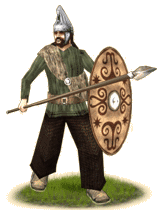 The tribes that came into contact with the Hellenic poleis founded on the western shores of the Pontos Euxine formed a distinct breed of warriors. These men were renowned for their fierceness, and all Makedonian expeditions sent against them effectively disappeared in the "Getic wasteland", while Makedonian kings like Lysimakos knew Getic captivity. Their contact with the Hellenic poleis made them well familiarized with the phalanx formation. These men are equipped with Phrygian helmets, padded leather armor and large oval shields. For weapons, they carry a spear and a sica into battle, similar to most Hellenic phalanx soldiers. The tribes that came into contact with the Hellenic poleis founded on the western shores of the Pontos Euxine formed a distinct breed of warriors. These men were renowned for their fierceness, and all Makedonian expeditions sent against them effectively disappeared in the "Getic wasteland", while Makedonian kings like Lysimakos knew Getic captivity. Their contact with the Hellenic poleis made them well familiarized with the phalanx formation. These men are equipped with Phrygian helmets, padded leather armor and large oval shields. For weapons, they carry a spear and a sica into battle, similar to most Hellenic phalanx soldiers.
Historically, the Getai who lived near the western shore of the Pontus Euxine were the most Hellenized. They were praised and feared as mercenaries. They were also very successful in some of their battles against the Greeks, and later against the Romans. Due to the more relaxed phalanx they adopted and favored by their light armor the Hellenes often engaged them against non-phalanx medium infantry, like peltastai or thureophoroi. Herodotus wrote that these Getai were "the bravest and most righteous of all Thraikians". Most take this to mean they were the most dogmatic of the Thraikians, fitting the religious zeal the Getai often showed later. They often showed pragmatism when dealing with the Hellenic colonies, often forcing these into a protectorate status; their direct commercial and cultural contacts with the poleis helped them to rapidly advance to high degrees of civilization, although their tribal traditions still held strong.
Ktistai (Dacian Noble Cavalry)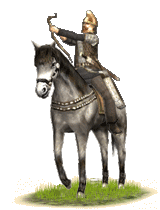 These men, the Ktistai, or "the ones set apart" are members of the most prestigious Getic priesthood. Apart from fulfilling many important roles in Getic society, some of the ktistai (all drawn from the tarabostes nobility) also form small cavalry forces of elite warriors. Thanks to wealth and military education, they are elite warriors who know how to use the bow and the falx, the two most important weapons in Getic society. Their armor is also of high quality: the Ktistai ride to battle armored with mail shirts, greaves covered with baggy trousers and animal fur worn on the back. They are good marksmen and should be used in that role when possible, but if a cavalry charge is necessary the Ktistai can perform that role well too. The Ktistai will never break, disobey or act without orders, and more than other warriors, truly believe their souls immortal. They can only be recruited in places with a highly developed religious infrastructure. These men, the Ktistai, or "the ones set apart" are members of the most prestigious Getic priesthood. Apart from fulfilling many important roles in Getic society, some of the ktistai (all drawn from the tarabostes nobility) also form small cavalry forces of elite warriors. Thanks to wealth and military education, they are elite warriors who know how to use the bow and the falx, the two most important weapons in Getic society. Their armor is also of high quality: the Ktistai ride to battle armored with mail shirts, greaves covered with baggy trousers and animal fur worn on the back. They are good marksmen and should be used in that role when possible, but if a cavalry charge is necessary the Ktistai can perform that role well too. The Ktistai will never break, disobey or act without orders, and more than other warriors, truly believe their souls immortal. They can only be recruited in places with a highly developed religious infrastructure.
Historically, the Ktistai were the highest tier of the Getic priests, drawn from the most promising of the Getic nobility. They had the reputation of being able to give immortality to the ones of their choosing. The Ktistai were organized in similar fashion to the Celtic druids, performing almost the same tasks of seers, historians, judges, as well as being renowned doctors, astronomers and astrologers. It is thought that they, or at least some sects of them, were harsh ascetics, forgoing meats and sexual relations in order to purify themselves for service to the gods.
Komatai Thorakitai Stratiotai (Dacian Heavy Phalanx)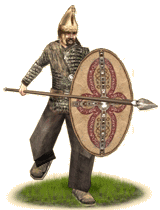 These troops were raised once the Getic state reached a strong level of organization. The rank and file of the Getic professional troops, these men are well adapted to dense forested areas, thus their cohesion does not suffer from fighting in rough terrain when in close formation. These warriors wear mail shirts, armguards, and Phrygian helmets over their traditional wool shirts and baggy trousers, befitting their status as professionals. They are also armed with spears, large oval shields and the sica. They are best employed to hold the line where the fighting will be the fiercest. Nevertheless, after discarding their spears, their small siccae and large oval shields still allow them to perform a similar role on the battlefield as that of the Roman legionaries, spreading in loose lines for close-combat and using their short curved swords for fast thrusts from behind their large shields. These troops were raised once the Getic state reached a strong level of organization. The rank and file of the Getic professional troops, these men are well adapted to dense forested areas, thus their cohesion does not suffer from fighting in rough terrain when in close formation. These warriors wear mail shirts, armguards, and Phrygian helmets over their traditional wool shirts and baggy trousers, befitting their status as professionals. They are also armed with spears, large oval shields and the sica. They are best employed to hold the line where the fighting will be the fiercest. Nevertheless, after discarding their spears, their small siccae and large oval shields still allow them to perform a similar role on the battlefield as that of the Roman legionaries, spreading in loose lines for close-combat and using their short curved swords for fast thrusts from behind their large shields.
Historically, the Thorakitai Stratiotai were assembled when the Getic kings decided they had enough strength to counter the tarabostes' ambitions. Professional troops, they garrisoned the most important dava, or fortifications, thus securing the vital strategic points the king needed to impose his authority. Well-armed and armored they served as the nucleus for the Getic infantry on the battlefield.
Tarabostes (Thracian Medium Cavalry)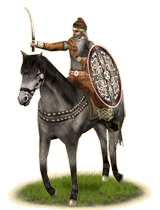 The Tarabostes are mounted war bands comprising warriors, usually veterans, attached to a war chief. They often form the main volunteer force for pillage raids. Being attached to the Getic nobility these warriors often have better equipment than their fellow Getic warriors. They are armored with chain-mail, armguards, greaves and large oval shields. They carry a spear and the sica blade. They are fearsome all-round cavalry, well armored and looking upon war as a class-affair. Their overconfidence, combined with Getic religious beliefs, makes these men prone to charge against tremendous odds as long as their chieftain is alive; thus, they lack the discipline required to any elite cavalry, but their traditional ferocity can always turn the tide of battle if properly timed or by sheer luck. The Tarabostes are mounted war bands comprising warriors, usually veterans, attached to a war chief. They often form the main volunteer force for pillage raids. Being attached to the Getic nobility these warriors often have better equipment than their fellow Getic warriors. They are armored with chain-mail, armguards, greaves and large oval shields. They carry a spear and the sica blade. They are fearsome all-round cavalry, well armored and looking upon war as a class-affair. Their overconfidence, combined with Getic religious beliefs, makes these men prone to charge against tremendous odds as long as their chieftain is alive; thus, they lack the discipline required to any elite cavalry, but their traditional ferocity can always turn the tide of battle if properly timed or by sheer luck.
Historically, the tarabostes had a much more independent spirit than any centralized authority would have preferred. Each of the more important tarabostes houses seems to have had its own dava (fortification) and each house maintained rather large forces at their own expense; their troops were experienced and loyal, bound to their leader through a system of privileges and favors. These warbands proved their worth during Burebista's campaigns against the Boii and Taursicii, where they seemed to have had the upper edge over the Celtic cavalry. Still, precisely these forces provided the tarabostes the needed self-confidence when they assassinated Burebista in 44 B.C., upon hearing the news that Caesar no longer threatened the kingdom's borders.
Phylakes Daoi (Dacian Bodyguards)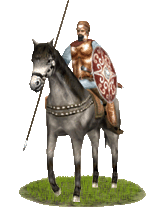 The strong ties developed between royalty and the ktistai priesthood made these zealots the perfect recruitement basin for the king's guards. The beltistai's loyalty is unquestionable and their ferocity unmatched. The strong ties developed between royalty and the ktistai priesthood made these zealots the perfect recruitement basin for the king's guards. The beltistai's loyalty is unquestionable and their ferocity unmatched.
Historically, the numbers of these guards would have been greater than presented in-game, thus acting as a nucleus for the royal cavalry. The ktistai were so close to the king, that the succesor would either be chosen from their ranks, or become pontifex maximus of the priesthood. The ones recruited for the beltistai korps must have been trained from infancy, while the secretive nature of their order must have been ideal for the purposes of any strong ruler.
Thraikioi Doryphoroi (Thracian Light Spearmen)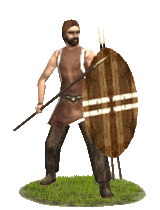 Among the Thraikian tribes, the vast majority of men of military age are too poor to fight in the bands of well-equipped units. As farmers, herders, and general pastoralists, many of these Thraikians cannot afford more than a few pieces of military equipment. For that reason many of them carry simple wooden shields, a clutch of javelins with fire-hardened wooden tips, and a simple spear. While many of the warriors who perform service for their tribe are these farmers, herders, and fishermen, many of them are also accustomed to a form of warfare through their incessant, low intensity squabbles with neighboring tribes, or even through occasional raids on passing trading parties or local trading emporia. So while they lack good weaponry, or armor, they carry a ferocious disposition - they are Thraikians, after all. While they may carry their ferocity on to the battlefield, their lack of experience in much of anything larger than a skirmish over farmland may cause their ferocity to dissipate in the face of prolonged hand-to-hand combat with well-ordered, or even professional, soldiery. They are accustomed to short skirmishes and decisive charges, and so are best used in similar roles. Among the Thraikian tribes, the vast majority of men of military age are too poor to fight in the bands of well-equipped units. As farmers, herders, and general pastoralists, many of these Thraikians cannot afford more than a few pieces of military equipment. For that reason many of them carry simple wooden shields, a clutch of javelins with fire-hardened wooden tips, and a simple spear. While many of the warriors who perform service for their tribe are these farmers, herders, and fishermen, many of them are also accustomed to a form of warfare through their incessant, low intensity squabbles with neighboring tribes, or even through occasional raids on passing trading parties or local trading emporia. So while they lack good weaponry, or armor, they carry a ferocious disposition - they are Thraikians, after all. While they may carry their ferocity on to the battlefield, their lack of experience in much of anything larger than a skirmish over farmland may cause their ferocity to dissipate in the face of prolonged hand-to-hand combat with well-ordered, or even professional, soldiery. They are accustomed to short skirmishes and decisive charges, and so are best used in similar roles.
Taxeis Triballoi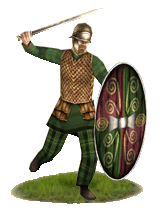 The Triballoi are a particularly fierce Thraikian tribe that contributes a very deadly assault infantry to any Thraikian warlord or any strategos who hires them. These Thraikians are wearing leather armor with ptyreges, leather greaves, Thracian helms and thureos shields and they are armed with javelins and Skythian longswords. True to their Thraikian ancestry they are ferocious warriors who fight with an intensity unmatched by other troops in the region. They are more than capable of going toe to toe with most other medium infantry and can be utterly lethal as flankers against heavier infantry. Their javelins give them another edge, as they can unleash a volley or two before closing in on the hopefully thinned enemy formation. In short, they are a very able assault infantry if properly used on the battlefield. The Triballoi are a particularly fierce Thraikian tribe that contributes a very deadly assault infantry to any Thraikian warlord or any strategos who hires them. These Thraikians are wearing leather armor with ptyreges, leather greaves, Thracian helms and thureos shields and they are armed with javelins and Skythian longswords. True to their Thraikian ancestry they are ferocious warriors who fight with an intensity unmatched by other troops in the region. They are more than capable of going toe to toe with most other medium infantry and can be utterly lethal as flankers against heavier infantry. Their javelins give them another edge, as they can unleash a volley or two before closing in on the hopefully thinned enemy formation. In short, they are a very able assault infantry if properly used on the battlefield.
Historically, the Triballoi were among the most fierce and warlike of the Thracian tribes, although that has been said about most Thracian tribes. However, it might have more merit for the Triballoi, as they were a byword for savagery and an Athenian club for lawless youths was named after them. The Triballoi were once subdued by Philippos II, and then again by Alexandros. Alexandros was so impressed by them that he hired many and brought them on his Persian expedition. They were instrumental as assault infantry, and were able to outfight the Persian infantry on every occasion that they met them. These troops had a simple philosophy of war. Throw javelins, charge, and then rip your enemies apart. For such simple tactics, they were wildly effective against most enemies.
The Triballoi were in constant contact with the Getai and Skythians and also the Illyrians. One Illyrian tribe, the Autariatai, overcame the Triballi around 424 and forced them out of their original homelands further south than their present location and they were also hard pressed centuries later when the Celts migrated to the area. The Skythian, Illyrian and later Celtic influences on the Triballoi might be the reason they are sometimes mentioned as distinct from the other Thracian tribes.
Thraikioi Hippeis (Thracian Light Cavalry)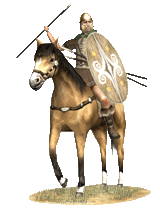 Thraikoi Hippeis are skilled Thracian skirmisher cavalry who harass their enemies with javelins. To maintain high mobility they wear no armor beneath their characteristic cloaks (called "zeira"), but their small thureos shields and Phrygian helmets with cheek guards provide some protection from their foes. They are trained in the use of the wedge formation and their Scordisci swords can be effective in close quarter fighting, but they are best used harassing infantry or slower cavalry at range. Thraikoi Hippeis are skilled Thracian skirmisher cavalry who harass their enemies with javelins. To maintain high mobility they wear no armor beneath their characteristic cloaks (called "zeira"), but their small thureos shields and Phrygian helmets with cheek guards provide some protection from their foes. They are trained in the use of the wedge formation and their Scordisci swords can be effective in close quarter fighting, but they are best used harassing infantry or slower cavalry at range.
Historically, these hard-fighting troopers were known for their fearlessness and swift maneuverability. They adopted hit-and-run cavalry tactics after their many encounters with the Skythians, making the Thraikoi Hippeis the bane of heavier and slower enemies. Megas Aleksandros employed Thracian skirmisher cavalry in his journeys, and their reputation was that of hard-drinking, uninhibited people. In battle they preferred to throw the first volley of cornel-wood javelins at maximum range so they could quickly ready a follow-up volley.
Thraikioi Peltastai (Thracian Peltasts)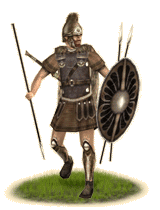 The Thracian Peltast was the originator and the best of the peltasts and these men will often give a better service than their Hellenic counterparts. They are armored in good quality linen and carry a smaller version of the thureos style shield. They are Hellenized warriors, but still have their trademark wild beards, which serve to remind their enemies of their country of origin. They are expert javelinmen, able to pepper their targets with javelins before charging in with their fearsome rhomphaias. They are well trained and among the fiercest and most feared warriors in the entire world, and they know it. This often makes them very impetuous, but an able general should be able to keep them at bay until the right moment. Thrakioi Peltastai can be used with equal precision as skirmishers or medium shock infantry. They are even deadly against armored horsemen, due to their wicked armor-piercing blades. The Thracian Peltast was the originator and the best of the peltasts and these men will often give a better service than their Hellenic counterparts. They are armored in good quality linen and carry a smaller version of the thureos style shield. They are Hellenized warriors, but still have their trademark wild beards, which serve to remind their enemies of their country of origin. They are expert javelinmen, able to pepper their targets with javelins before charging in with their fearsome rhomphaias. They are well trained and among the fiercest and most feared warriors in the entire world, and they know it. This often makes them very impetuous, but an able general should be able to keep them at bay until the right moment. Thrakioi Peltastai can be used with equal precision as skirmishers or medium shock infantry. They are even deadly against armored horsemen, due to their wicked armor-piercing blades.
Historically, the Thraikioi Peltastai have been around since the late Bronze Age and are often considered the archetype of the Thracian warrior, though these Hellenized Peltastai are considerably more heavily armored than their fifth century ancestors. The Thrakioi Peltastai have been plying their deadly trade against Hellenes for as long as any Thrakian or Hellene can remember, and their method of warfare was so effective it was copied by the Hellenes and Makedonians and even mimicked by tribes as distant as the Illyrians. The number of battles and by whom they were used is uncountable. Suffice to say Thrakian peltastai have been used in every major conflict between Hellenic states, and will continue to be used.
Thraikioi Rhomphaiaphoroi (Elite Thracian Infantry)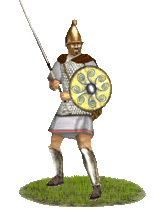 The elite infantry of the Thraikian tribes are armed with the heaviest of Thraikian weapons, the rhomphaia. Unlike most other Thraikian warriors, these warriors can afford relatively heavy armor and are thus armored with chain mail or scale cuirasses, Phrygian helmets--often with elaborately moulded cheek pieces, bronze greaves and a pelta. They are armored infantry killers of great renown, well able to chop their way through heavily armored enemy soldiers. These soldiers can even be effective against armored horsemen, since their large rhomphaia have been known to sheer through the legs of horses. In the right hands, this band of warriors can be a devastating battle-winning force in itself. The elite infantry of the Thraikian tribes are armed with the heaviest of Thraikian weapons, the rhomphaia. Unlike most other Thraikian warriors, these warriors can afford relatively heavy armor and are thus armored with chain mail or scale cuirasses, Phrygian helmets--often with elaborately moulded cheek pieces, bronze greaves and a pelta. They are armored infantry killers of great renown, well able to chop their way through heavily armored enemy soldiers. These soldiers can even be effective against armored horsemen, since their large rhomphaia have been known to sheer through the legs of horses. In the right hands, this band of warriors can be a devastating battle-winning force in itself.
Historically, there were relatively few of these soldiers in any Thraikian army, but they were always at the forefront, where the fighting was thickest. Each had risen to a position of power within his respective tribe, often they formed the elite troops of the chief or local king. The Rhomphaiaphoroi represent the pinnacle of the Thracian military know-how. In the old Thraikian way of battle, the Rhomphaiaphoroi would form the brunt of a decisive charge, once the Peltastai had worn down the enemy. Their charge was nearly unstoppable, and often led to outright routs against less stalwart opponents, as their fearful Rhomphaia, sturdy weapons composed of nearly two meters of heavy iron, could pierce thick armor, and cleave limb from torso with little trouble. With their row of long iron points, bands of Rhomphaiaphoroi could also defend against oncoming horse, and when wielded by a skilled swordsman a single blow could hamstring a horse or sever an enemy’s limbs.
Thrakioi Prodromoi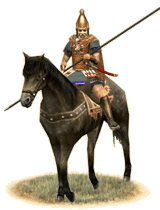 In the Thraikian and Makedonian armies, these medium cavalry are a common sight. The reason for this is that they are excellent medium cavalry, capable of skirmishing, charging, and fighting fairly well in melee. They are armored with good quality linen, bronze helms, and the distinctive Thraikian shields that mark their country of origin. They are an extremely versatile cavalry force that can be given the moniker ‘jack of all trades and master of none’. They are great all-round cavalry, but will not fare well against heavier cavalry or spear or pike armed infantry. They are drawn from the lower Thraikian nobility and many have settled in Makedonia, lured by land grants and higher pay. In the Thraikian and Makedonian armies, these medium cavalry are a common sight. The reason for this is that they are excellent medium cavalry, capable of skirmishing, charging, and fighting fairly well in melee. They are armored with good quality linen, bronze helms, and the distinctive Thraikian shields that mark their country of origin. They are an extremely versatile cavalry force that can be given the moniker ‘jack of all trades and master of none’. They are great all-round cavalry, but will not fare well against heavier cavalry or spear or pike armed infantry. They are drawn from the lower Thraikian nobility and many have settled in Makedonia, lured by land grants and higher pay.
Historically, Thraikian light cavalry was some of the best in the ancient world. They proved their worth in battle after battle, whether in Makedonian or Hellene service, or the service of their own kings. Their tactical versatility made them a light cavalry equivalent to the Romaioi legions, well able to perform any battle role and to adapt quickly to any circumstance.
|
 |
|
 |






















|